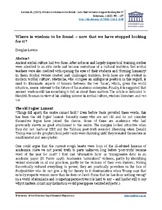| dc.contributor.author | Lawrie, Douglas G. | |
| dc.date.accessioned | 2018-01-04T11:35:07Z | |
| dc.date.available | 2018-01-04T11:35:07Z | |
| dc.date.issued | 2017 | |
| dc.identifier.citation | Lawrie, D. (2017). Where is wisdom to be found – now that we have stopped looking for it? Scirptura, 116(2): 93 – 107 | en_US |
| dc.identifier.issn | 0254-1807 | |
| dc.identifier.uri | http://dx.doi.org/10.7833/116-2-1315 | |
| dc.identifier.uri | http://hdl.handle.net/10566/3349 | |
| dc.description.abstract | Ancient scribal culture had two faces. After arduous and largely impractical training, scribes were admitted to an elite circle and became custodians of a cultural tradition. But scribal teachers were also credited with opening the eyes of their students and ‘forming humanity’ in them. Scribal writers created and challenged tradition. Both faces are still evident in modern ‘scribal culture’. Nietzsche, who occupies an ambiguous position in this regard, is used to illuminate aspects of tension between the two ‘faces’, which, given the world situation, seems relevant to the future of the academic enterprise. Finally, it is suggested that ancient wisdom still has something to tell us about these matters. The article is dedicated to Hendrik Bosman in view of his abiding interest in scribal culture, wisdom literature and הוהי תאר | en_US |
| dc.language.iso | en | en_US |
| dc.publisher | SUN | en_US |
| dc.rights | This is the author-version of the article published online at: http://dx.doi.org/10.7833/116-2-1315 | |
| dc.subject | Nietzsche | en_US |
| dc.subject | Scribes | en_US |
| dc.subject | Wisdom | en_US |
| dc.subject | Literacy | en_US |
| dc.subject | Elitism | en_US |
| dc.title | Where is wisdom to be found – now that we have stopped looking for it? | en_US |
| dc.type | Article | en_US |
| dc.privacy.showsubmitter | FALSE | |
| dc.status.ispeerreviewed | TRUE | |

